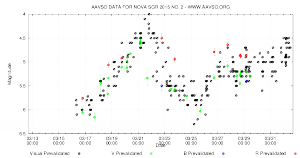On Sunday March 15th, nova hunter John Seach of Chatsworth Island, NSW, Australia, found a new 6th-magnitude star shining in three search images taken by his DSLR patrol camera. The time of the photos was March 15.634 UT. One night earlier, the camera recorded nothing there to a limiting magnitude of 10.5.
A spectrum taken a day after the discovery confirmed that this is a bright classical nova — a white dwarf whose thin surface layer underwent a hydrogen-fusion explosion — of the type rich in ionized iron. The spectrum showed emission lines from debris expanding at about 2,800 km per second. It looks yellowish.
Our ASSA Photometry and Spectroscopy Section Director’s work was mentioned in Sky and Telescope magazine – see the extract from the article below and the spectrum he obtained.
Well done Jerome!
“Here’s a colour image of its spectrum taken March 17th, by Jerome Jooste in South Africa using a Star Analyser spectrograph on an 8-inch reflector. Note the wide, bright emission lines. They’re flanked on their short-wavelength ends by blue-shifted dark absorption lines: the classic P Cygni profile of a star with a thick, fast-expanding cooler shell or wind” – Sky and Telescope
After fading to 6th magnitude the nova has re-brightened to magnitude 4.5 at the end of March as shown in the AAVSO light curve below.


